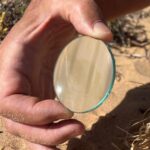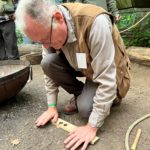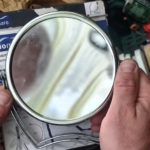At the Global Bushcraft Symposium 2022 in the UK, Gordon Dedman presented the bow drilling technique he teaches in Australia. Since readers are assumed to know the basics of bow drill friction fire lighting, I will only concentrate on specific aspects of this technique as taught by Gordon.
Setting up the bow drill set
My post about Australian woods for friction fire lighting discussed the hearth board and spindle’s wood choice. It can be found here. In this article, I will discuss shapes, geometries, and hand drill friction fire lighting procedures.
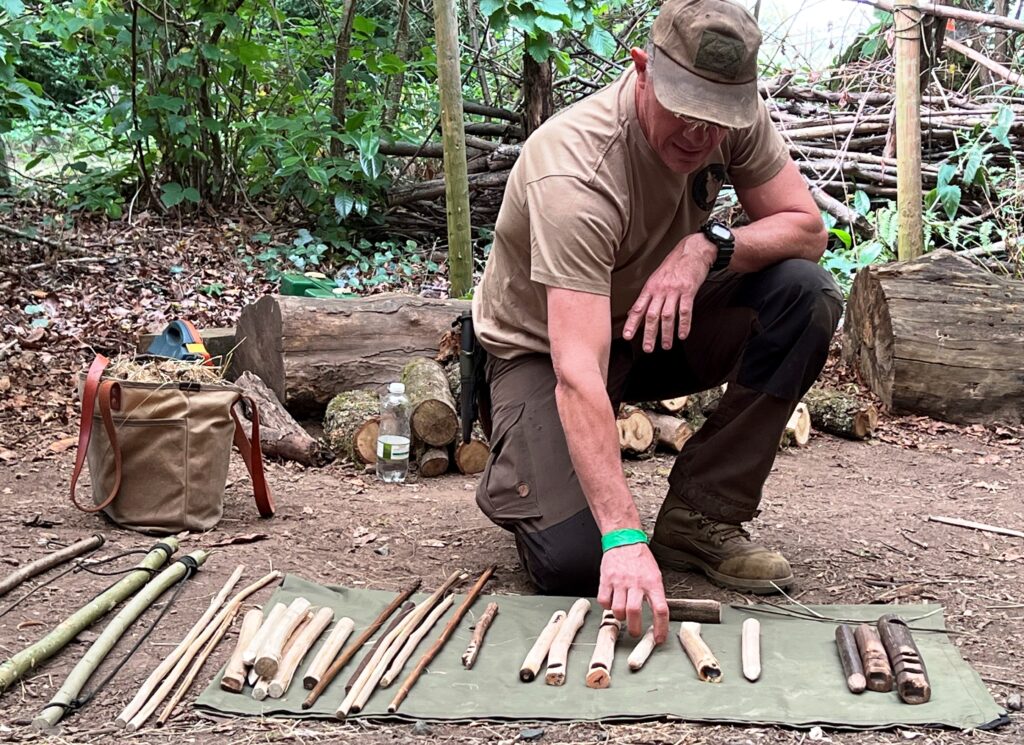
Hearth Board
For the hearth board for bow drilling in Australia, Gordon uses sticks of the same wood as the spindles but only about 1,2-1,5 times wider than the spindle. That means the hearth board is comparatively slim compared to the spindle and very often from the same dead and dry piece of wood. The length of the hearth board should be enough to burn another 3 or 4 friction fire holes into it and still have enough space to hold it down with one of the feet securely. The hearth board should be flat at the bottom so that it can be held down with a foot without moving or vibrating. No ember will be formed if it vibrates, but only dust will accumulate. Gordon also cuts a flat sidewall where the notch will be located.
Spindle

The spindle length depends again on various factors, like the thickness of the hearth board, length of the lower leg, and thickness of the holding block a.s.o., but a length of about 35 cm is suitable in most cases. As always, on the lower-/friction side, the shape of the spindle should be half-round, and on the upper-/bearing side, a pronounced, long tip should be cut.
Bow
As a bow for bow drilling in Australia, Gordon uses thick, stout pieces of green wood of any species with a length of about one meter, using about 80 cm of net length for his stroking action. The bow stick can be either straight or slightly bent, and most bow sticks he uses are between 3 – 4 cm thick. Gordon prefers to see an inclined V-notch on either end. On the upper back, he attaches the string in the notch with a snare knot; at the lower end (which he holds in his hand), he secures the string with a good number of half-hitches.
String
Gordon uses Paracord (between 3.5 – 5 mm thickness) as a string. He fits new string cords so that there is only a slight slack in the final mounted cord on the bow, as the new Paracord will stretch up to a certain point. For already used Paracord strings, the slack below a virtual straight line between the two anchor points depends on the spindle thickness, but as a rule of thumb, about 3 cm slack should be fine. In case the grip of the string on the spindle is not enough, and the spindle starts slipping, the following measures can be taken according to Gordon:
- Unknotting and tightening up the string, or
- Gripping the string on the bow further up the line or
- Moving the bow away from the spindle during the stroking action
- Using a thicker spindle
Alternatively, any strong and uniformly thick string can be used if no Paracord is available.
Holding block and others
Gordon uses green hardwood pieces, which are half-round on the upper side, as a holding block for bow drilling in Australia. The bearing hole is cut with a knife in the middle of the block. If the block is slightly dry already, he spits into the hole for lubrication. The blade for catching the ember and useful tinder, plus its preparation, were already discussed in my former post about Australian woods for friction fire lighting.
Burning-in the bow drill set
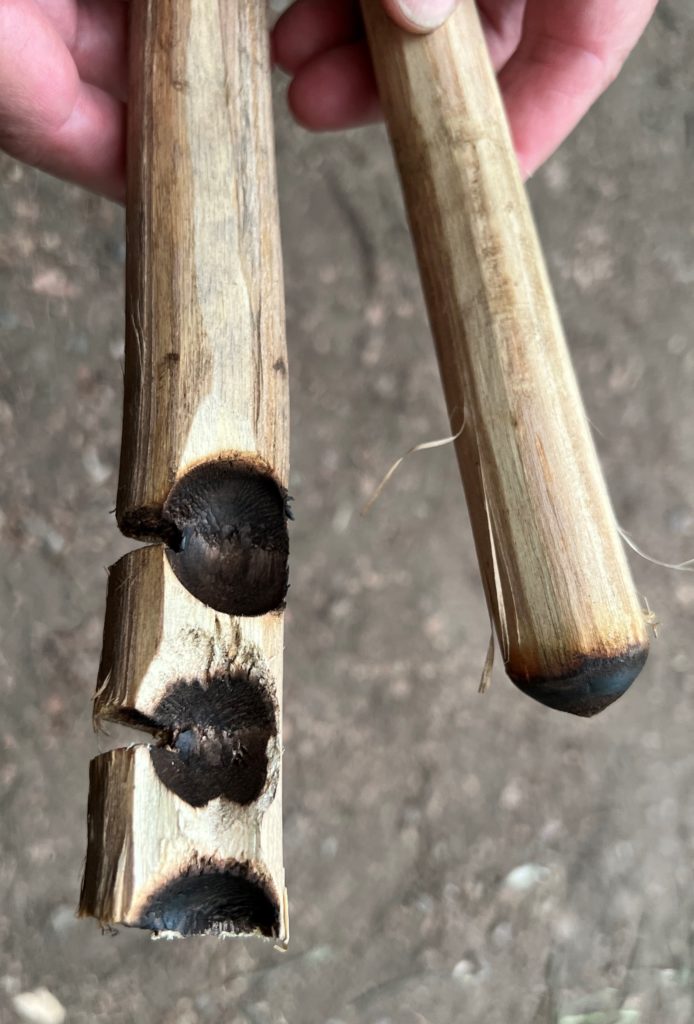
Due to the hearth board’s slim width, Gordon always had a good idea of where precisely to center the spindle. He placed the spindle so there was still a secure sidewall but not too much wood to remove for the notch. After that, burning in is done as everywhere else in the world, from a cautious start until the first smoke appears and some strokes further.
Cutting the notch at the hearth board
Notch-cutting is again done the same as everywhere else, but Gordon is not shy of having improved the notching efficiency. Sometimes, he cuts the notch with a handsaw and cleans it with the knife. That’s by far faster than a knife.
.
Producing an ember with the bow drill
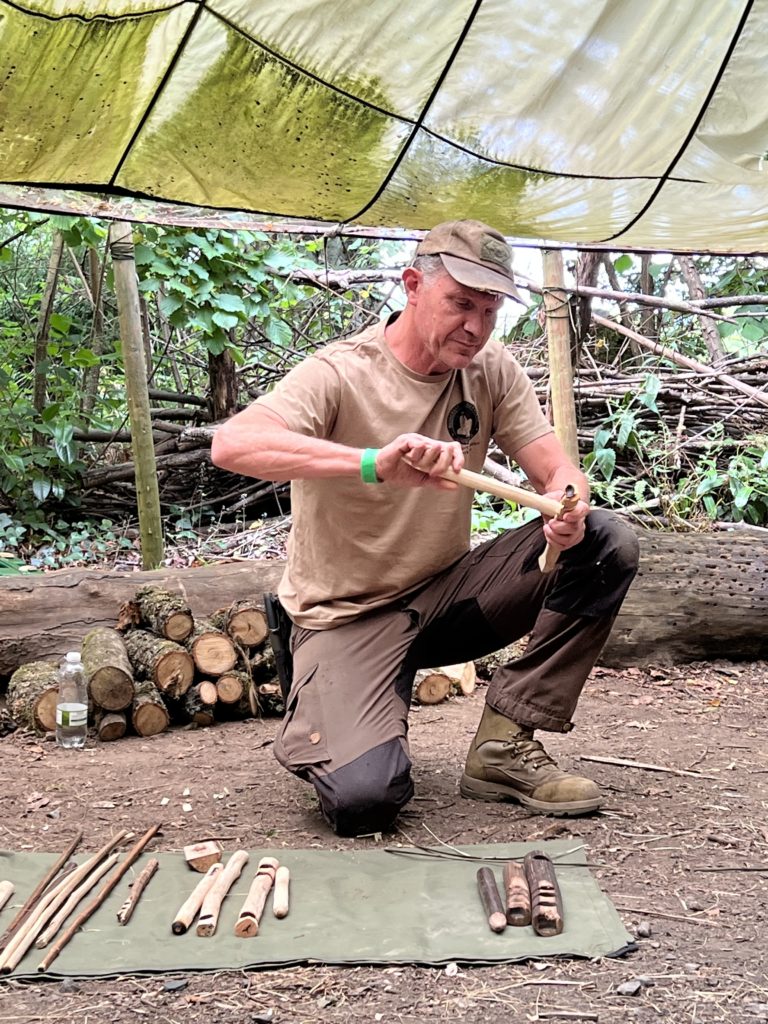
Before starting to produce ember, Gordon always checks the sidewalls and bottoms of both the hearth board and spindle and cleans out with the knife whatever could negatively influence the action, such as charred sidewalls, glazed areas, or elevated pits at the bottom, which increase the friction area.
After ensuring that all his bow drill parts are in optimal shape and fit each other, he ensures the availability of a proper ‘bird nest’, fire pit, enough kindling in four different sizes, and suitable firewood. Only thereafter will he start producing embers.
He assembles the bow drill and starts stroking, and – depending on the used wood species – he either increases pressure on the holding block, increases the stroking speed, or does both. Necessary regulations of speed and pressure will be felt and heard around a ‘sweet spot.’ If the spindle starts squeaking, the pressure has to be increased on the holding block; if only dust is produced (and there are no board vibrations), the speed must be increased.
When stroking, the most important according to Gordon, are the following factors:
- The thumb-hand wrist area is securely pressing onto the shinbone, avoiding vibrations to the spindle
- All strokes are parallel to the ground, and scooping is avoided, as this will move the string up and down the spindle
Gordon produced embers with various types of Australian woods every time within about 30 seconds in dry weather in Wales, UK. Typically, for the last 10 seconds, he did high-speed stroking.
Treatment of the ember
The hearth board was carefully removed from the ember on a woodchip. The remaining dust was put with fingers onto the ember and left consolidating for 1 or 2 minutes like it is done everywhere else.
Blowing the grass bundle into a flame
Again, the same standard procedure applies everywhere else. Ember was put into the grass bundle, slightly closed, with long, continuous, and directed blows activated. After every long blow and sidewards moving action with the bundle in hand – blow again. Until the smoke starts to turn yellow and the bundle breaks into flames. When this happens, the grass bundle is turned around so that the flames are burning up into new grass blades and are transferred to the fire pit. Kindling crisscross atop and, after that, putting on firewood pyramid style.
Lessons learned from Gordon about bow drill fire lighting
- Hearth board and spindle for bow drilling in Australia can be from the same stick
- There is no need for a wide hearth board; a little bit thicker than the spindle is enough
- The bow should be a stout piece of green wood
- Notch cutting with a saw is easier
- The pressure on the block and the speed of strokes are essential.
- Always try to feel and hear the sweet spot
Global Bushcraft Symposium 2022 (GBS2022) and Gordon Dedman
GBS2022 was held from 27th-31st July 2022 at Llyn Tegid (Bala Lake), within Snowdonia National Park, in North Wales, UK.
Gordon Dedman founded Bushcraft Survival Australia (BSA), an outdoor bushcraft survival school dedicated to teaching genuine and authentic modern and traditional outdoor living skills through carefully designed educational courses.
Gordon is a former member of the Australian Army 1st Commando Regiment and is currently a survival instructor in NORFORCE, an Australian Army Reserve Regional Force Surveillance Unit (RFSU). NORFORCE conducts patrols in remote areas of Northern Australia, working closely with Aboriginal communities. Gordon is also a Combat Survival SERE instructor (Survival Evasion Resistance Escape) and regularly instructs on RAAF Combat Survival Training School Courses in North Queensland.
He has trained at and completed numerous Survival and Bushcraft courses and certifications worldwide at leading schools run by Paul Kirtley (Frontier Bushcraft UK), Ray Mears (Woodlore Bushcraft UK), Dave Canterbury (Pathfinder School USA), Lofty Wiseman (Trueways Survival UK), Richard Hungerford (Bushlore Australia QLD) and Bob Cooper (Bob Cooper Outback Survival WA).
Gordon works seasonally as an outdoor guide in the Northern Territory, taking clients on camping expeditions into Kakadu and Arnhemland. A full bio of Gordon Dedman can be found here.
There are videos on his YouTube channel in various parts of Australia about friction fires and using various Tinders, which can be accessed here.
Gordon reviewed this post on August 12, 2022, suggested some included changes, and had no further objections.
Further readings about Fire-making on this website:
Creating fire with a magnifying glass
Hadza hand drill friction fire
Bow Drilling – following the method of Mattias Norberg
Giant Fennel stalks for lighting fire
Batwa pygmies traditional fire lighting method
Manketti wood for friction fire lighting
Bushscout UK’s fire bundle basket
Fire lighting with Flint & Steel
Hand drilling in UK as taught by Dave Watson
Bow drill standard procedure by Dave Watson
Hand drill friction fire lighting in Australia
Creating fire by hand drill in Namibia
Australian friction fire wood species
.


